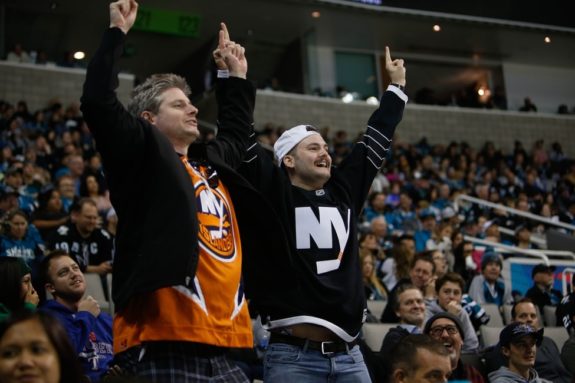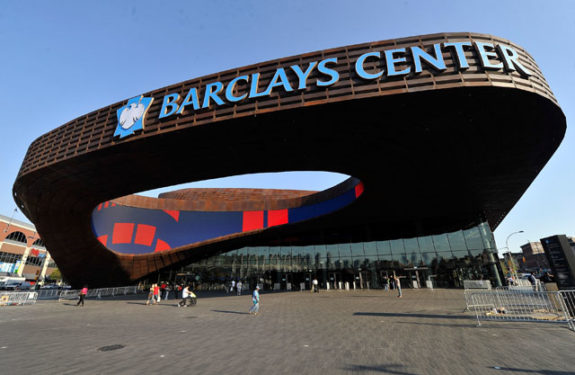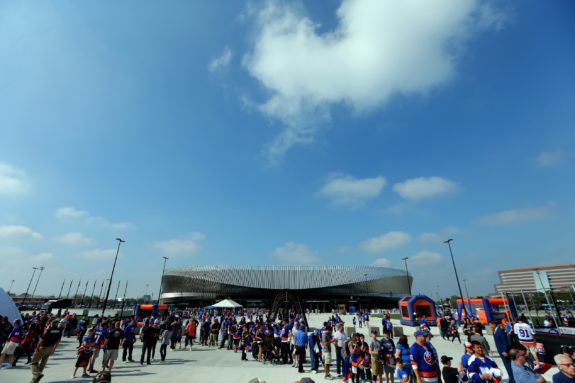Being a New York Islanders fan is not easy. Since the early 1980s when the team won four consecutive Stanley Cups, playoff appearances have been few and far between, making it difficult for fans to find anything to cheer about for an extended period of time. The news that they will finally be building a state-of-the-art, permanent home adjacent to Belmont Racetrack provided reason to cheer, but the recent loss of John Tavares to the Toronto Maple Leafs via free agency means that their longtime star and current captain won’t be with them when they get there.
To make things even more fun for the fans as they wait for the new building in Belmont, over the next three years, the Islanders plan to divide their home games between two arenas: the Barclays Center, which has been their Brooklyn home since the 2015-2016 season, and the refurbished Nassau Coliseum, now dubbed the NYCB Live’s Nassau Veterans Memorial Coliseum, which was their Uniondale, Long Island home prior to the move to Brooklyn.
It was originally announced that for this season, the Islanders would play 12 games at the NYCB Live arena and complete the rest of their schedule at the Barclays Center. Later, that plan was amended by adding eight more games, increasing the number of games played in their former Long Island home to 20, and reducing the number of Brooklyn games to an almost equal 21. So this will truly be a divided season for the team and its fans.

Islanders Arena Timeline
To understand the circumstances that created this unusual situation, it is helpful to look at a timeline of the team’s arena journey.
1972 – The Nassau Coliseum opens its doors in Uniondale to become the home arena for the NBA’s New York Nets and one of the NHL’s newest expansion teams, the New York Islanders.
1980-83 – The New York Islanders win four consecutive Stanley Cup championships representing the high water mark of hockey activity in the Coliseum’s history.
The 1990s – The Coliseum is showing its age. During this decade, it is alternately referred to affectionately as “the old barn” when the team is playing well, or “the crumbling old building” during the more frequent non-playoff years.
The 2000s – By the early part of the decade, the Coliseum has become embarrassingly outdated compared to other NHL arenas. But locked into a long-term lease, Islanders ownership has very little leverage to negotiate a needed makeover.
2004 – Islanders majority owner Charles Wang proposes the Lighthouse Project. This is an ambitious $37-billion real estate development proposal that would use private funding to build office space, upscale housing, a luxury hotel, an entertainment complex, and a new arena for the Islanders on the property currently occupied and surrounding the Nassau Coliseum. The project was rejected by local authorities in the Town of Hempstead as too dense for the area.
2010 – Nassau County Executive Ed Mangano introduces a $400-million referendum to renovate the Coliseum using taxpayer dollars. It is rejected by voters in 2011.
2012 – After years of futile attempts to work out an improvement plan for the aging Coliseum, Charles Wang announces that the Islanders will be moving their home base to the Barclays Center in Brooklyn.
2014-15 – The Islanders play their last season at the Nassau Coliseum.
2015-16 – The Islanders play their first season at the Barclays Center. Almost immediately, fans begin to complain about bad ice, obstructed views, and difficulty with train travel to the arena. Shortly afterward, team representatives begin echoing some of these complaints.
2017 – New York Governor Andrew Cuomo announces that the Islanders have been awarded the right to build a new arena at the Belmont Park site.
2018 – The Islanders announced that the team will be dividing its home schedule between Brooklyn and Uniondale for the next three years while the Belmont arena is being built.

Playing in Brooklyn
The Islanders left Uniondale because they were in an unacceptable situation. They played in an outdated arena that wasn’t working for the team or the fans. They did not have the support needed from local authorities or the community for the significant upgrade their building required. With no other options in the New York area, the team signed a 25-year lease to play in the Barclays Center.
After three seasons in Brooklyn, the team once again finds itself in an unacceptable situation. Ice conditions at the Barclays Center are terrible. Arena ownership has no interest in investing the time or money to address that. Attendance for games is low. Although the arena can seat 15,795 people for hockey, average attendance this past season was only 12,002, resting near the bottom of the league.
Of course, it doesn’t help that most of the seats in the West end of the arena are sold as “limited” view. For a good number of those seats, the limitation is that you cannot see the goal below you. Let me repeat that: you cannot see the goal below you. How can any true hockey fan enjoy a game without being able to see the goal?
The root cause for this problem is that the rink does not fit in the arena. Let me repeat that: the rink does not fit in the arena. The Barclays Center was built for basketball only. Placing a hockey rink into it is like squeezing a king-size bed into a child’s bedroom. You may fit it in, but you won’t be able to open your closets anymore. On top of that, commuting to games using the Long Island Railroad turned out not to be as user-friendly as advertised.

Playing on Long Island
Faced with these problems, it is no wonder that everyone wants to get back to Long Island. But the NYCB Live’s Nassau Coliseum has its challenges too. Until the Belmont arena deal was secured, even NHL commissioner Gary Bettman was on record as saying the building was unacceptable for NHL hockey. That is after the 18-month, $165-million renovation project it underwent after the Islanders left for Brooklyn.
The new arena boasts an exterior of 4,700 brushed aluminum fins (that remind me of the back of an old air conditioner), but underneath that lay the remnants of the whitewashed “crumbling old building” along with the old problems that plagued fans during the first go around: overcrowded hallways, long lines for concessions, and not enough restrooms leading to ever-worsening conditions during the course of a game.
After the renovations, the outer concourse has been widened, the interior walkway has been redesigned, and the bathrooms have been remodeled. But seating capacity has been reduced to 13,900 ensuring that the team will not be breaking attendance records in this building either.
At least fans will once again be able to hold tailgate parties in the parking lot before games, and honk their horns in rhythm to the “Let’s Go Islanders” chant as they fight their way back into the traffic on Hempstead Turnpike after games.
Barclays Center vs. NYCB Live’s Nassau Coliseum
With these two options, it will be interesting to track attendance this season, especially for key games. With essentially half of the schedule being played in each venue, Islanders fans will be splitting time between the arenas like children of divorced parents shuttling back and forth between two homes. Who gets the good weekends? Will promotional events be held in both places like two Thanksgiving dinners? What happens come playoff time?
What about the players? Will they have a preference for mom’s house or dad’s house? Will traveling between two homes wear the team out, like so many extra road trips? What happens to their home-ice advantage? How will the team be able to attract free agents while playing in two arenas? Will this arrangement truly continue for three years?
The two-home approach raises a lot of questions. The 2018-2019 season will give us our first set of answers.